March 2014 Archives
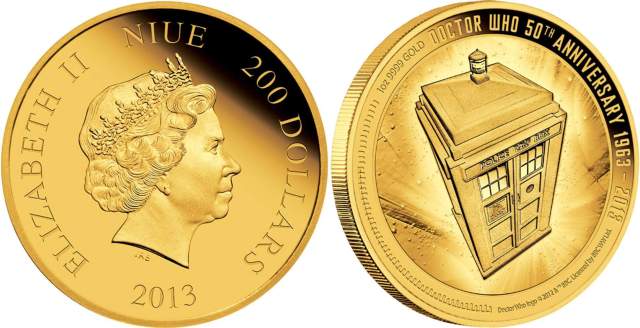
Niue 2013 $200 1oz Gold Proof Coin Tardis Design Doctor Who 50th Anniversary 1963-2013 Mintage 250, struck by the Perth Mint for the New Zealand Mint, trademark designs used under official license from BBC (image courtesy the Perth Mint)
Who would have thought that 50 years after the first televised screening of the British Doctor Who science fiction series on Saturday 23rd November 1963, Doctor Who would still be so popular today, enjoying world-wide appeal and spawning a merchandising arm running into the billions of dollars.
Granted there was a 16 year hiatus -the series was retired in 1989, with an unsuccessful attempt to re-launch in 1996, but finally making a successful revival in 2005, and still being aired today. And during all that time, the show's plot hasn't changed:
• it's all about the story of a time-travelling "Time Lord" male called "The Doctor" - human in appearance but an alien on the run from his own people, the Time Lords of the planet Gallifrey
• The Doctor travels through time and space, sorting out the universe, mankind, alien races and righting wrongs
• Collecting beautiful female "assistants" along the way from the different "earth" time zones he visits, to help him with his quests
• And travelling in his time machine called "The Tardis", a blue British police box, now phased out due to the use of mobile telecommunications. These police boxes were fitted with fixed telephones for police use, or as a visual landmark where the public could contact the police - in essence, a tiny police station inside a telephone booth.
The Doctor Who show was initially developed as an educational program, exploring science and famous moments throughout history. And in 1963 the world was certainly changing -there was the British political scandal "The Profumo Affair", the American Civil Rights Movement was in full swing, Reverend Martin Luther King Jr and President John Kennedy were inspiring and empowering the American nation, the Vietnam War and the Protest Movement was in full swing, the Japanese developed miniaturized TV & video sets, land speed records were being broken, The Beatles and The Rolling Stones took the world by storm, the US Mercury space mission completed 22 Earth orbits, Jacques-Yves Cousteau helped develop the first two-manned submarine, the first artificial heart pump was used ... the list goes on. On a sadder note, the British launch of the series was first aired straight after extended news coverage of President John Kennedy's assassination from the previous day.
The Doctor Who series also developed unique, ground-breaking and revolutionary props, sets, costume design, monsters and even music - most still being used today. Take for instance the "Sonic Screwdriver" introduced in 1968 and still incorporated into modern scripts - it had a myriad of "functions" - from performing medical scans, to tracking alien life, to controlling the properties of atoms and molecules.
"The Dalek" characters, a completely new look and concept for a monster, almost didn't make it into the storyline. The BBC forbade the producers to use "bug-eyed monsters" (as they called it) but as it was the only finalized script available at the time of filming, the Daleks made their first appearance in the second series and have been an iconic character ever since.
During the 1970's, the show came under fire for being unsuitable for children - too frightening and too gory. In fact the phrase "hiding behind (or "watching from behind") the sofa" is a direct reference to the scariness of the Dr Who shows. In 2011 Dr Who was voted as being the "scariest TV show of all time" (credit: Digital Spy online survey results).
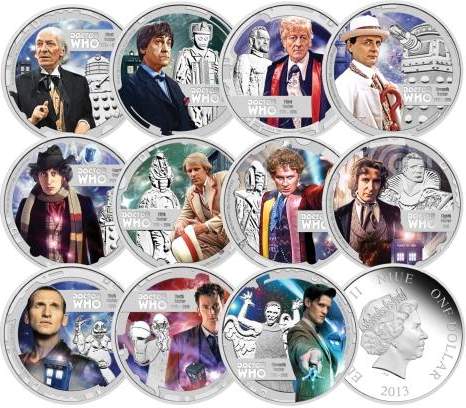
2013 Niue 11 x 1/2 oz Fine Silver Proof Dollar Coins 11 Doctors Coloured Set, Mintage 4,000 of each coin, 3,000 in this set presented in a Fob Watch case. (image courtesy New Zealand Mint, trademark designs used under official license from BBC, minted by the Perth Mint and distributed by the New Zealand Mint, legal tender of Niue)
The most pivotal part of the storyline is Doctor Who regenerating himself as he travels through the ages, allowing for different actors to play the part, with the role constantly changing and evolving. To date there have been twelve Doctor Who's with the latest Doctor being played by Peter Capaldi from Christmas Day, Wednesday 25th December 2013.
Besides watching the television series, Australian's can also attend a major exhibition touring through all major cities, between April and June 2014 - "The Science of Doctor Who - Australian Tour 2014".
Or even better, why not purchase the officially licensed, 50th Anniversary Doctor Who coins, depicting eleven of the twelve Doctor Who's. Or how about a collection of the Doctor Who monsters released throughout 2014? There's even a specially minted 1oz fine silver coloured coin from the Perth Mint housed in it's own 3D Tardis model display case that plays the time machine's sound effects when opened -all minted as legal tender for the pacific island of Niue.
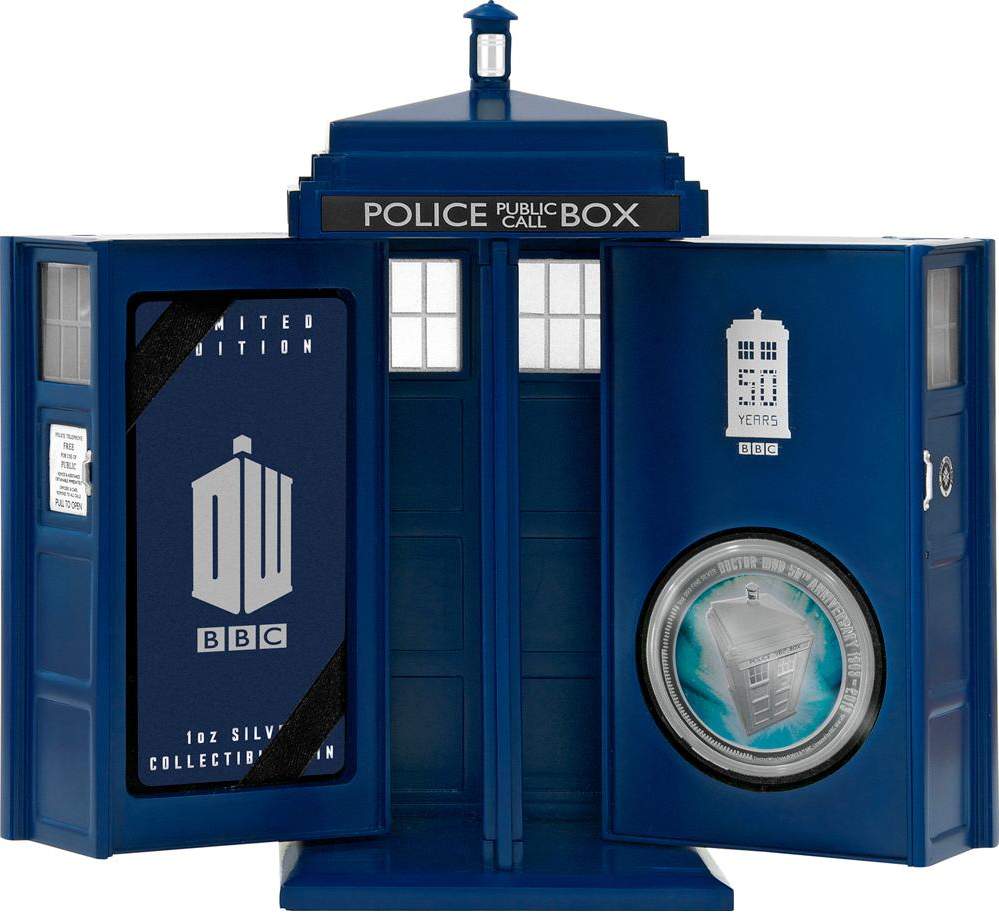
Niue 2013 $2 1oz Silver Proof Coin Tardis Design Doctor Who 50th Anniversary 1963-2013 in Tardis Display Case Mintage 10,000, struck by the Perth Mint for the New Zealand Mint, trademark designs used under official license from BBC (image courtesy the Perth Mint)
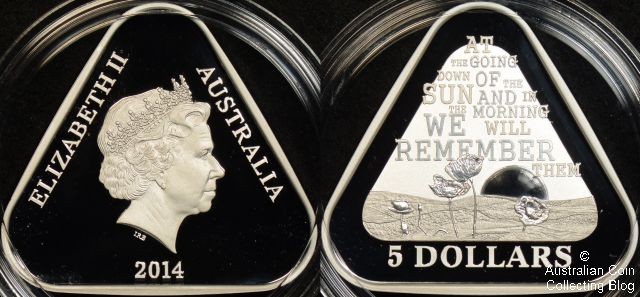
2014 ANZAC Lest We Forget $5 Triangular Proof Coin (image courtesy www.ramint.gov.au)
The Royal Australian Mint's Anzac Centenary Coin Program has begun with this new release in the popular triangle shape in the unpopular 5 dollar denomination. Don't however be deterred by this, the theme is popular, very collectable and with the Anzac centenary upon us we'll be seeing many many more releases in this coin program as well as a 2014 commemorative dollar coin in circulation. This triangular silver proof coin is limited to a mintage of just 10,000 and is sure to prove very popular with collectors, military enthusiasts and those who simply want to remember. The first coin we saw in this same triangular shape was last year, the 25th anniversary of Parliament House 5 dollar triangular coin and sold out very quickly.
Sit in silence, pay your respects and recite the text on the reverse of the coin depicted over the symbolic dawn scene with the sunrise and red poppies blowing in the breeze. This coin a tribute to those who served.
With a frosted proof finish this $5 coin weighs 22.23 grams, is 33.9 millimetres in diameter and is struck in 99.9% fine silver. It's presented in a protective capsule in a box with a certificate of authenticity for $85. The obverse features the Ian Rank-Broadley effigy of Queen Elizabeth II. Release date is March 27th 2014.
Update: 31/3/14 This issue is proving extremely popular with demand far outweighing stock of this coin even before it's release date. Currently unavailable at the Mint.
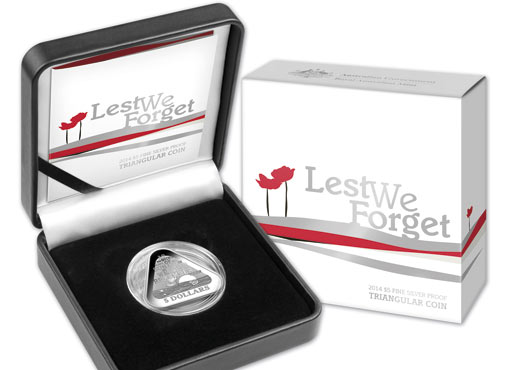
2014 ANZAC Lest We Forget $5 Triangular Proof Packaging (image courtesy www.ramint.gov.au)
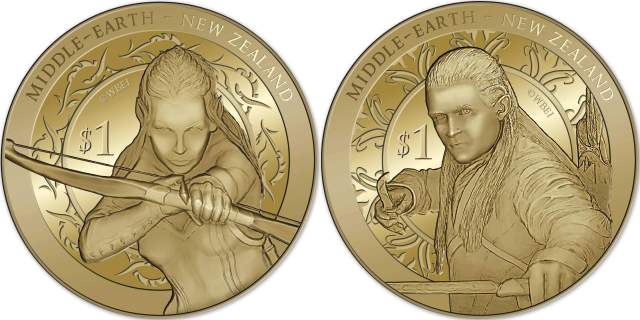
2013 New Zealand Al/Zn/Br Uncirculated Dollar 2 Coin Set. The Hobbit: The Desolation of Smaug featuring The Elves Tauriel (left) and Legolas (right) (image courtesy www.ramint.gov.au)
Have you visited the south island of New Zealand? If you have then you'll know that this country has the most incredible scenery - green pastures, snow capped peaks, slow moving glaciers, fast running streams lined with flat oval pebbles, beautiful flat lakes ringed by magnificent trees, inviting whimsical forests - just perfect for a movie set. If you're a fan of author J.R.R. Tolkien's books, or just a fantasy movie buff, then you're more than aware that I'm writing about the incredible New Zealand scenery that was the perfect backdrop for the Lord of the Rings movie trilogy and more recently, The Hobbit movie trilogy - with the last movie in this series "There and Back Again" anticipated to be released during December 2014.
Tolkien's books have so captured the imagination of the 21st century, it's hard to comprehend that the first inklings of what was to come was published in a poem "The Voyage of Eärendel the Evening Star," in September 1914 when he was just 22. The Hobbit (the first of his books) was actually published in 1937 when he was 45 years old, with the Lord of the Rings being published even later in 1954. Considering Tolkien survived World War I, even fighting in the trenches; then after the war coming to terms with an emerging, reshaped, resettled, reborne Europe; it's not so hard to imagine how someone could fantasize about war and desolate landscapes; idyllic fairy-like utopia's; the testing of allegiances; even the development of new cultures, languages and races - in fact, a New World Order.
While the books are brilliantly imagined on paper, it's proven incredibly difficult to adapt to other mediums and it was only in 1953 that St. Margaret's School in Edinburgh claimed to be the 1st authorized stage production and adaptation of "The Hobbit". Since then, there's been a 12 minute cartoon stills cinema adaptation in 1966, an 8-part British BBC Radio 4 drama broadcast in 1968, and even an American animated tele-movie in 1977. But it was the Soviets in 1985, who produced the first live-action motion picture "Сказочное путеше�твие ми�тера Бильбо Беггин�а Хоббита", translated into English "The Fabulous Journey of Mr. Bilbo Baggins the Hobbit". It's then been a gap of almost 10 years to 1993, before the screening of the Finnish live-action, 9 episode, televised mini-series.

2013 New Zealand 1oz Gold Proof $10 3 Coin Set (limited to just 250 sets issued at AUD$9,725). The Hobbit: The Desolation of Smaug featuring Thranduil (left), Bilbo Baggins (middle) and Azog (right) (image courtesy www.ramint.gov.au)
For just a lump sum payment of £10,000 (roughly AUD $18,300 in today's currency) plus a 7.5% royalty after costs, Tolkien sold the film and merchandising rights of The Hobbit to United Artists in 1969. Considering that the Box Office revenue on just the first two Hobbit movies alone (An Unexpected Journey and The Desolation of Smaug) is an estimated US $1,960,960,993 - not to mention all the merchandising to take into account - it's very sad that Tolkien never witnessed the mega industry that is the spin off from his vivid imagination - he died in 1973.
While we all know that New Zealand provided the spectacular backdrop for the movies, what is probably not well known is that in 2010 the movies were almost filmed in Eastern Europe rather than New Zealand due to an industrial dispute. Thousands of New Zealanders quickly organized mass protest rallies to proclaim the New Zealand economy was in jeopardy of being $1.5 billion worse off if production moved offshore. Exhaustive talks and rapid changes to trade union legislation saved the day.
To commemorate the pride and love New Zealanders have for these movies being made in their country, and of-course to mark the movies phenomenal success, a range of coins have been minted annually by the Royal Australian Mint since 2012. Struck in Australia these coins are New Zealand legal tender and are released by New Zealand Post. Ranging from aluminium/zinc/bronze and fine silver $1 coins right through to 1 ounce $10 gold coins, some sold as individual coins and others as 2, 3 and 5 coin sets, they all depict the movies various characters, with the 2012 coins in particular inscribed in both English and Dwarvish with the words "Middle Earth - New Zealand". All images depicted on the coins are copyright "WBEI" Warner Brothers Entertainment Inc.
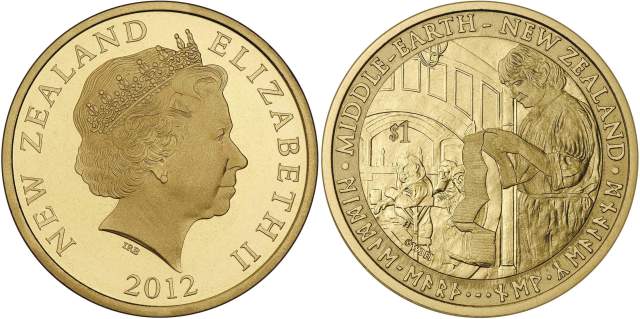
2012 New Zealand Al/Zn/Br Uncirculated Dollar The Hobbit: An Unexpected Journey featuring Bilbo Baggins at his home -Bag End (image courtesy www.ramint.gov.au)
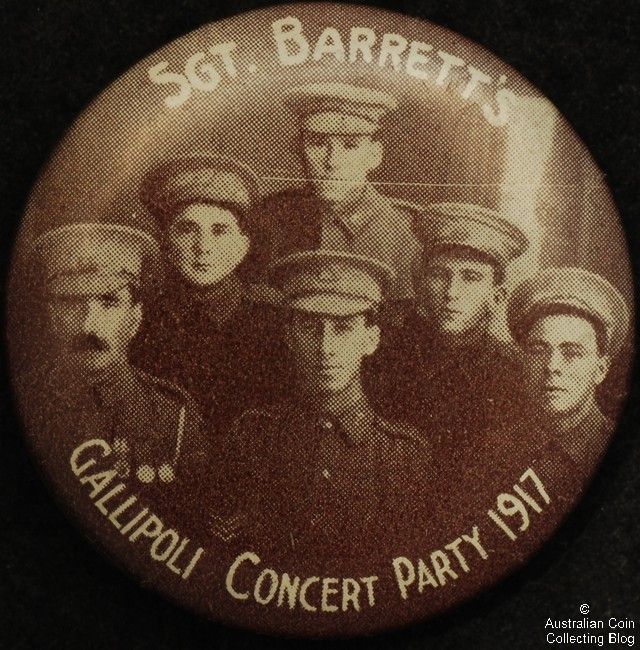
Sgt. Barrett Gallipoli Party 1917 Tin Badge
This badge measures 32mm and is tin-backed with a spring pin mount. The black and white image of 6 Australian World War 1 soldiers appears to be printed on paper and coated in celluloid. The legend reads "SGT BARRETT's GALLIPOLI CONCERT PARTY". To date we are aware of three types of Barrett tin badges and this seems to be the most common.
Sergeant Barrett appears to be one Sergeant J.R. (James Robert) Barrett who served in the 9th Light Horse. Research we have conducted suggests he lived in Glenelg, South Australia. He enlisted in the 9th Light Horse in 1914 and left Australia as a private for the middle east in 1915. It seems that he served well at Gallipoli and was injured at least two times, once receiving a broken arm and a second time receiving a shell wound to the groin. He also appears to have succumbed to illness (as did many at Gallipoli). Because of the mental and physical impact of the illness and the injury to his groin he was declared medically unfit and was returned to Australia in 1916 on medical grounds as a sergeant.
At some stage it appears that Barrett chose to form and lead an entertainment troupe to tour small venues around Australia. Presumably he did this to help to raise funds for the war effort or for returned veterans. Part of this fund raising effort almost certainly involved selling these badges, which was a common method of fund-raising in Australia during WW1 and immediately after the war. We can find evidence that Barrett was conducting concerts in both 1917 and 1918 in venues as far apart as Broken Hill in the far west of New South Wales and Victor Harbor in the south of South Australia.
References:
Barrier Miner, Friday 13 July 1917, Page 3 "Gallipoli Concert Party"
Barrier Miner, Saturday 14 July 1917, Page 5 "Gallipoli Concert Party"
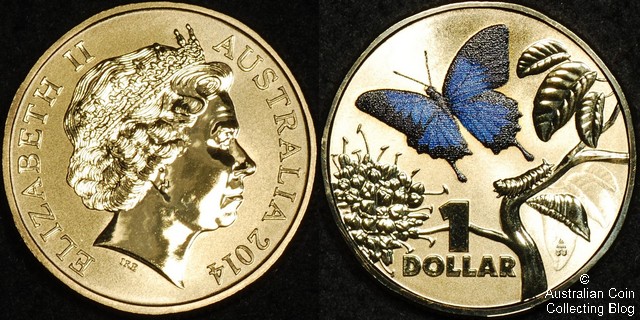
Pad Printed Colour Ulysses Butterfly Australian Dollar Coin in the Bright Bugs Series
If you've ever been fortunate enough to have visited the tropical rainforests of Queensland, Australia no doubt your experience has been made all the more memorable by glimpsing, usually just out of peripheral vision, flashes of the most beautiful shimmering iridescent electric-blue you've ever seen. That's the Ulysess Butterfly, also called the Blue Mountain Butterfly or Blue Mountain Swallowtail.
It's very difficult though to spot a Ulysses Butterfly at rest - when not in flight they close their wings to hide their upper wing colour of iridescent blue, revealing the lower wing colour of dull brown - the perfect camouflage in the leaf canopy, making them almost disappear. It's the opening and closing of their wings in flight, revealing blue then brown, that makes their flight so spectacular.
The colour blue is completely irresistible to the male Ulysses Butterfly, who can spot that flash of iridescent blue from over 30 meters away. So next time you're walking through the forest and multiple butterflies appear, remember to take note of the colour of your clothing - these butterflies might just be thinking that you're the "lady of their dreams".
If you live in the tropical regions of Australia, planting the Pink Evodia as a butterfly host plant (botanical name being "Melicope ellerana" or more commonly called the "Corkwood", the "pink-flowered Doughwood" or the "Butterfly Tree") will certainly attract the Ulysses Butterfly into your garden as they lay their eggs underneath it's leaves, with the added benefit of the leaves being the best food source for the butterfly larvae. However, the Ulysses Butterfly has also been known to make the best use of citrus foliage as well (lemon and orange trees in particular). It's been proven that female butterflies can smell the correct host plant for their species from huge distances - a good skill to have with butterfly food source becoming rare as human habitation invades the forested areas.
Be aware though that the Pink Evodia is a messy tree - it's clusters of small pink flowers sprout from it's branches and appear to resemble balls of fluff from a distance; it will continually drop branches throughout it's life span; and at the end of the flowering season, the pink flowers become brown fruits with black seeds, that litter the garden floor around the tree. But the trade off is of-course attracting the Ulysses Butterfly, not to mention attracting Parrots, Rainbow Lorikeets and Honeyeaters who also find the flower nectar and brown fruits irresistible. Take care though where you plant this tree - when fully grown, it's height can be anywhere from 10 through to 25 metres tall! And remember that surrounding plants and shrubs may also end up being butterfly larvae dinner.
As the emblem for Queensland Tourism and being incredibly beautiful, it's no wonder that the Ulysses Butterfly is one of six $1 colour printed, frosted, uncirculated coins minted by the Royal Australian Mint in the "Bright Bugs" series - a collection of six coins portraying "the prettiest bugs from around the country" with the catchy phrase "there's more to this bright bug than meets the eye". This coin is paired with the Blow Fly coin in the first release for 2014.
This 25 millimetre aluminium bronze $1 coin depicts the Ulysses Butterfly "life cycle" designed by Aaron Baggio - from the food source of the Pink Evodia tree, leaves and flowers; through to egg, pupa and then larvae stage; through to the transformation into the beautiful Ulysses Butterfly pad printed in vibrant colour. With the obverse depicting the older standard portrait of Queen Elizabeth II, designed by Ian Rank-Broadley. The coin is issued at $15.00 with a capped 30,000 mintage.
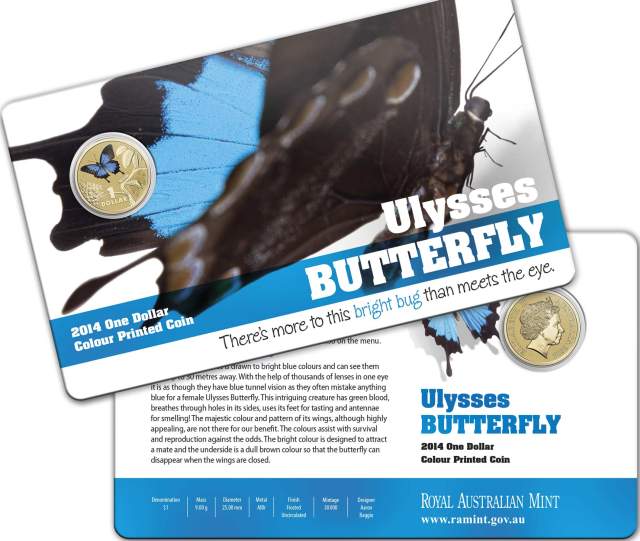
Ulysses Butterfly Bright Bugs Collector Card (image courtesy www.ramint.gov.au)
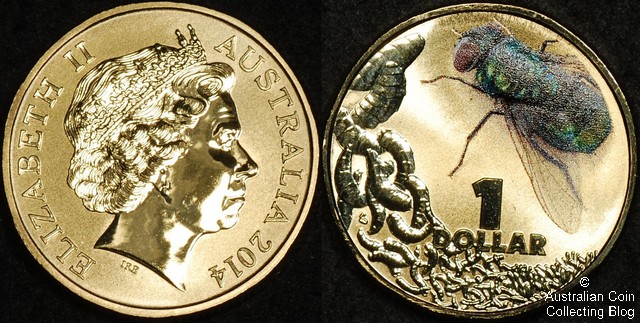
Pad Printed Colour Blow Fly in the Bright Bugs Series
The first two coins in a new series of coloured one dollar coins from the Royal Australian Mint have been released with one sure to have you reaching for the can of Mortein. A series of coins featuring Bright Bugs scrapes the bottom of the rotting carcass to bring you the Blow Fly complete with squirming maggots. The Blow Fly coloured reverse design is by Bronwyn King, the Mint's newest coin designing talent. Ms King was a student at CIT, the Canberra Institute of Technology and won a design award from the Mint as a student in 2012 and now with her Graphic Design degree in hand is designing collector coins.
The Australian Sheep Blowfly (Lucilia Cuprina) adorns the reverse of this coin with it's blue, green and black metallic exoskeleton shining in pad printed colour. Maggots in various stages of growth are also a relief design feature on this coin. Around the world there are 1,100 species of Calliphoridae or blow flies and if you haven't gone all squeamish then you will soon.
Nope, can't do it, you'll have to ask Google if you would like to know more about the Blow Fly especially the larvae, it is particularly grotesque. They live in poo and are attracted to strong unpleasant odours. They feed on our live sheep costing the agricultural industry an estimated $175 million each year. Some maggots are even specially bred for medicinal purposes cleansing dead tissue in wounds that just won't heal. Following the life-cycle they can even be relied on as evidence in forensic investigations.
The Bright Bugs series comprises of six Australian legal tender one dollar coins, this one and the Ulysses Butterfly have been released in February 2014 with four others to follow throughout the year. The next in the series will be the Cuckoo Wasp and the Rainbow Stagbeetle. The Blow Fly $1 is presented in a capsule in a colourful collector card -and just to be a nuisance the card is a different size to other series. Each coin is struck on an aluminium bronze planchet, weighs 9 grams and is 25 millimetres in diameter with interrupted edge milling. The finish is frosted uncirculated. The effigy of Queen Elizabeth II is by Ian Rank-Broadley and is the standard obverse. Mintage will be capped at a maximum of 30,000 coins. This coin is issued for $15.
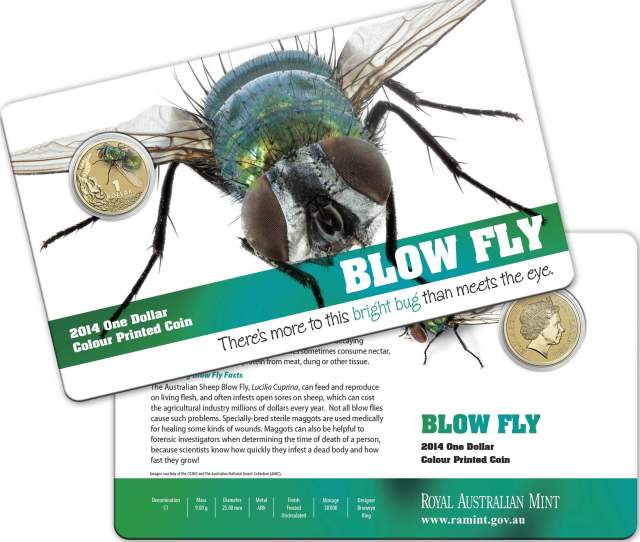
Blow Fly Bright Bugs Collector Card (image courtesy www.ramint.gov.au)
A great friend of the Blog has passed on a verbal show report for readers keen to know how the show is going in the west this weekend. The annual Perth ANDA Coin and Banknote show is being held today and tomorrow at the Belmont Racecourse and show visitors queued early today for the 10 o'clock start. Getting there proved difficult for some with the racecourse boasting proximity to the Belmont Park Railway Station but the station non-operational unless it's a racing day. The show had good attendance early despite this problem and poor air conditioning at the venue. There was also one other interesting problem, the location seemed overrun with flies -yes flies keen to visit the Royal Australian Mint and see their Bright Bug beauty on the RAM's latest release coin. Seriously, by the end of the day there were more sticky flies at the venue than show visitors.
Large queues were at the stands of both local Mints, the Perth Mint and the Royal Australian Mint where the portable press was striking P counterstamp A Voyage to Terra Australis dollars. Both hadn't sold out of their daily allocation of show specials by the end of the day.
Dealers attending included Pacific Rim Coins, Rainbow Rarities, Watermans Coins, VP Coins, Monetarium Adelaide, Unico, Phoenix Auctions, IAG, Prospect Stamps and Coins, Roxbury's, Trevor Wilkin Banknotes and local Sterling and Currency. Chris Meallin of Downies Australian Coin Auctions was also on hand taking consignments for the next public auction. Absentees most notable were Klaus Ford and JPW coins. Of course not all eastern dealers make the pilgrimage to the show in the far west but it was a good turnout.
That's it for the report on day 1, let's see what day 2 brings on the WA long Weekend for Labour Day.


